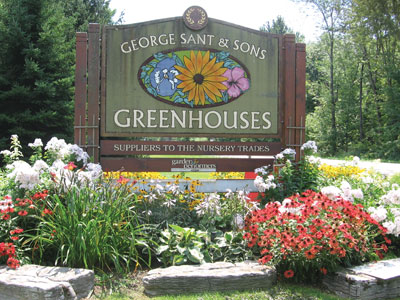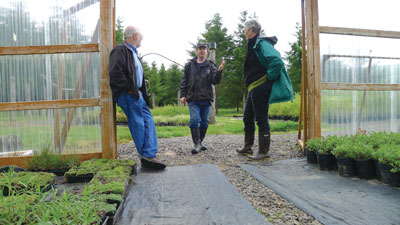
Sustainability certification pays.
Sustainability certification pays. That’s the message spreading across the Canadian greenhouse industry as the number of greenhouses participating in certification programs continues to grow.
 |
|
| An MPS auditor working on a greenhouse audit. Advertisement
|
In Part 1 of this feature (this issue), we outline the certification programs now available to Canadian growers, the differences and similarities among them, participation levels, and interviews with two Canadian greenhouse operators who have chosen to become certified.
In Part 2 next month, we will look closely at marketing certification, as well as cost return – how much participants save on average in energy efficiency, reduced water use, and so on. Certified Canadian greenhouse operations will comment on both aspects.
FOOD ALLIANCE
■ Oregon-based Food Alliance (FA) has offered a “Nursery and Greenhouse Standard” across North America since May 2012. The FA Standard addresses operational efficiencies (energy use, recycling, and so on), soil and water conservation, wildlife habitat and biodiversity conservation, adaptive management of pests, diseases and weeds, and safe and fair working conditions. The Standard currently applies to all greenhouse operations, including vegetables, cut flowers and ornamental plants, except those that use hydroponics. Since the Standard was launched in May, one nursery operation in Oregon has completed inspection and its certification is pending.
FA communications manager John Harrington says there are many reasons a grower should choose FA certification over other programs, including the fact that the FA Standard was developed specifically for North American growers.
“More than a Standard, it is a suite of sustainability business tools that can be used together or by component, depending on your objectives,” he adds. It is also comprehensive and respects grower expertise and innovation.
“The Standard’s criteria are designed to award credit for innovative practices that achieve the intended outcomes,” Harrington notes, “even if the innovation reflects a novel approach not explicitly listed within the criteria.”
The FA Standard is structured with fixed and scored criteria, with the latter relating to operational efficiencies and energy use. Inspectors score these points by considering an operation’s unique circumstances, such as regional weather.
SCS
■ SCS offers two certification options: Veriflora and “Certified Greenhouse Farmers” (CGF).
 |
|
| George Sant & Sons Greenhouses has been MPS certified since early 2011. PHOTO COURTESY MPS
|
While both programs require growers and other related businesses to meet strict environmental practices relating to product quality, resource conservation, energy efficiency, ecosystem protection, and integrated waste management, Veriflora has additional requirements that ensure a safe, equitable and healthy working environment.
There are three CGF growers in Canada at present: Leamington, Ontario-based Nature Fresh Farms (certified in August 2012), and two operations based in Delta, British Columbia (Houweling’s Tomatoes and Windset Farms).
“We also have one Veriflora-certified Canadian cut flower handler (St. Laurent, Quebec-based Sierra Flower Trading/Savoir Fleur) and seven certified Canadian peat moss producers,” says Dr. Michael Keyes, the principal auditor for CGF and Veriflora as well as a senior agricultural and natural resources specialist in SCS’s food and agriculture division.
“There are currently 20 U.S.-based SCS-certified ornamental plant producers and eight certified cut flower growers whose production is mostly from greenhouses.”
Keyes calls Veriflora “the strictest horticulture standard” that a grower can aspire to. “The SCS certifications are the ‘gold standard’ choices,” he says. ”They offer the greatest appeal to consumers in the marketplace who are looking for sustainable choices. They are the most stringent and therefore require higher-quality processes to be followed.”
The standard is the same worldwide, Keyes notes: “temperature and location make no difference.”
In late August, Certified Greenhouse Farmers announced a collaboration with certifier SureHarvest to form “the first comprehensive performance-based system in agriculture.”
It will focus on developing environmental metrics (water, energy and nutrient use efficiencies) that are scalable for various-sized growers.
Nature Fresh Farms joined Certified Greenhouse Farmers in August. The company produces peppers, tomatoes, cucumbers, eggplants and other crops outside and in 150 acres of greenhouse space. It utilizes a biomass wood-waste boiler system, raised-bed gutter production, and a 96 per cent-efficient water recirculation system.
It also uses an air-to-air exchange system to better manage humidity, reduce energy costs, and on still, hot summer days, provide a small degree of cooling.
When asked why NFF chose CGF, compliance co-ordinator Jeff Gagnon says, “CGF is not just another certification program, but a trade organization solely focused on the food production greenhouse industry. The CGF audit was very intensive.”
LEED – LEADERSHIP IN ENERGY AND ENVIRONMENTAL DESIGN
■ The U.S. Green Building Council (USGBC) created the LEED (Leadership in Energy and Environmental Design) rating system in 2000, and it is being updated this year. “We don’t have a rating system specific to greenhouses, but LEED is flexible enough to apply to all project types,” says USGBC communications manager Ashley Katz.
Two greenhouses have received LEED certification.
- The greenhouse at Phipps Conservatory in Pittsburgh recently received a Platinum certification, one of only two dozen buildings of any kind in the U.S. to achieve this.
- The Pennsylvania State University biology research greenhouse received LEED Silver in 2008.
In addition, the $42 million “Mars Centre for Science and Technology” in Norton, Mass., which has a rooftop observatory and greenhouse, has earned LEED Gold.
A few other greenhouse projects are registered for eventual LEED certification: Denver Botanic Gardens Greenhouse in Denver, University of Massachusetts Research & Education Greenhouse in Amherst, and the greenhouse facility at Joliet Junior College in Illinois.
This last project features three greenhouses totalling nearly 9,000 square feet, with a rainwater harvesting system, a passive ventilation system and an energy-reflective roof surface to reduce cooling loads.
MPS
■ Netherlands-based MPS began certifying in 1995 and is now active in more than 50 countries, with 3,500 participants worldwide.
Beginning in 2010, MPS began concentrating on the North American market “and we currently have 35 MPS-ABC participants, two of which are located in Canada,” says western USA MPS spokesperson Charlotte Smit. These are Canada Floral Greens in Langley, British Columbia, and George Sant & Sons in Kleinburg, Ontario. “In 2012 and 2013, we will further intensify our activities in the Canadian market.”
Smit says the MPS-ABC (ABC refers to MPS “environmental criteria packages” A, B and C) certification program is unique in many ways.
“One of them is that the program takes the location factors of a company into account,” she explains. “MPS-ABC is a unique program, which not only helps growers understand their achievement on the level of sustainability but also gives them detailed proactive management information (participants receive a report four times a year). Furthermore, the program is designed to compare your company to other colleague growers.”
Growers can also choose which certification is appropriate for their greenhouse operation, and are not obligated to implement requirements that do not fit their operation/activities, Smit says. “MPS is a non-profit organization run for and by growers.”
George Sant & Sons has been certified with MPS since early 2011, after collecting monthly reports since November 2010. The business is mainly a “rooting station” for Ball Horticultural Co., but it also grows a large amount of finished material (annuals and some perennials) for garden centres and landscapers. They have seven acres of greenhouse space and eight acres of outside growing space, with a full-time staff of about 15.
“We chose MPS because of its apparent sophistication,” says accounts manager Mark Sant. “It seemed to have a lot more exposure to the horticulture industry. We wanted to be MPS-certified in part because Ball insisted its suppliers all register, but for personal reasons as well. There is, of course, an advantage as far as marketing is concerned, but we are very conscious of global issues such as diminishing fresh water.”
SIERRA ECO
■ In 2000, St. Laurent, Quebec-based Sierra Flower Trading launched an umbrella marketing program called “Sierra Eco” for cut flowers. Florists or growers in the U.S. and Canada, who have been certified by one or more of certifiers Veriflora, Fair Trade, FlorVerde or Rainforest Alliance can register for “Sierra Eco.”
 |
|
| A Food Alliance inspection relating to its “Nursery and Greenhouse standard” at Native Grounds Nursery in Oregon. PHOTO COURTESY FOOD ALLIANCE
|
At present, there are no “Sierra Eco” greenhouse operations in Canada, but there are eight florists.
However, Louise Gadoury of the Sierra Flower Trading marketing department says that because as much as 35 per cent of the flowers sold by Sierra Flower Trading are “Sierra Eco,” and because Sierra Flower Trading is one of the largest suppliers to Canadian wholesalers of imported cut flowers (over 60 wholesalers), market penetration is good.
That was not the case at the start. The years following the launch of Sierra Eco included education of industry members, but progress made with consumers was quite slow.
“We had tried labelling Sierra Eco Flower sleeved bunches, but rarely were cut flowers kept in the original sleeves,” Gadoury says. “We considered labelling the individual flowers and foliages, but doing this is extremely costly and can affect quality. So, getting the message to consumers has been extremely difficult and so any type of brand recognition for sustainably produced flowers has remained remarkably low compared to other similar industries that have product packaging.”
To help with this, Sierra Eco will be publicizing the new website in early 2013 (for Valentine’s Day) and is encouraging florists and greenhouses certified with one or more of the four certifiers to register.
“We believe that Sierra Eco is the easiest and best way for consumers to recognize florists and greenhouse operators who care about social and environmental sustainability,” Gadoury says. “Word of mouth and social media will play a crucial role in encouraging consumers to ask for eco-friendly flowers, and the industry will continue to provide them.”
FOR MORE INFORMATION
- MPS – www.my-mps.com (contact Sandy Hering s.hering@usa.my-mps.com or Charlotte Smit c.smit@usa.my-mps.com).
- Food Alliance – www.foodalliance.org (contact John Harrington john@foodalliance.org).
- LEED – www.usgbc.org .
- SCS Global Services (Veriflora and Certified Greenhouse Farmers) – www.veriflora.com and www.certifiedgreenhouse.com (contact Nova Sayers nsayers@scscertified.com).
- Sierra Eco – www.sierraeco.com .
Treena Hein is the editor of Energy Edge.
Print this page